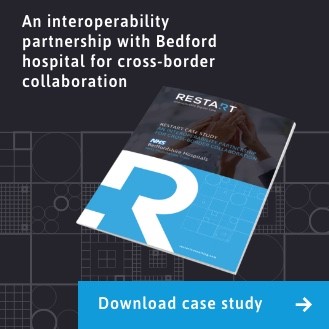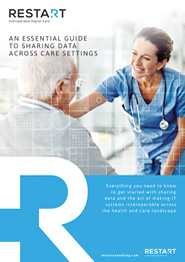How to implement the Minimum Viable Solution of your Shared Care Record by September 2021
NHSX CEO Matthew Gould recently announced that all 42 Sustainability and Transformation Partnerships/Integrated Care Systems (STP/ICS) organisations must have a Minimum Viable Solution (MVS) shared record in place by September 2021. There are nine months left to achieve this goal.
Shared Care Record procurement and deployment has generally taken much longer in those areas that have one. Is there an approach that meets these timescales? We take a look.
The requirements of a ‘basic’ shared care record – the MVS
Like many technology projects, the programme team’s first query is: what are the intended requirements and deliverables? In November HSJ reported that NHSX wanted a ‘basic’ level of record-sharing in place as set out by the Professional Record Standard Body in their Core Information Standard.
As well as general demographic information, this includes appointments, medications, care plans and more. The Core Information List includes over 1,500 data fields which might exist across hundreds of different IT systems. With NHSX wanting further interoperability of records to include NHS trusts, GPs and social care, organisations coming out to tender are shaping their own interpretation of what constitutes the MVS.
Integrated Care Systems and STPs are complex. Your ‘basic’ level of record sharing and your requirements, i.e. your MVS, will undoubtedly be different from another ICS/STP. How do you make sure you can design and deliver this interoperability for your teams’ requirements by September 2021?

Prioritise the objectives of your MVS
Keeping clear objectives at the forefront makes it easier to identify the indispensable critical elements needed for your shared care record. What are your clinical priorities?
- Is GP data shared in the hospitals within your STP/ICS, especially in ICU?
- Do you need to manage repeat testing by sharing lab data across the community?
- Does the wider system have visibility of allergies and alerts?
- Do you need better transitions of care?
Flexibility: Start small and build incremental programmes
It is essential to manage scope and appreciate the interoperability capabilities within your organisation. Start with the basics, add datasets incrementally and work at the pace your clinical teams can manage, between now and the end of Sept 2021.
Encourage clinical champions to support their communities through the change programme and adopt a common language to create a clear understanding of the proposed solution. A measure of success will be the level of buy-in from your clinician teams; if they don’t believe it in, how can they endorse it?
What’s the end goal?
A shared care record enables any user across any care setting to view the same information about a patient in real-time. Shared care records will pave the way to population health management, analytics and machine learning. The fundamental requirements for your MVS shared record and any procurement are:
- A detailed health and care record – view everything in one place, including documents, medications, appointments, results, scans and care plans.
- Real-time data flow across care settings – update information once and share immediately.
- Role-based access – ensure users only see the information they need for their care setting and role.
- Integration across all health and care settings – build with Open Technology for complete interoperability with existing sources whilst allowing for future changes.
- Read and write capability – allow users from all care settings to collaborate seamlessly.
- Single sign on authentication –enable users from all organisations to log in to the record using their existing credentials.
- Caseload lists – created by users and shared across care settings to promote collaborative working.
- An intuitive user interface – for users to quickly view patient information and activity from any care settings without the need for dedicated training.
- Cross-organisation search – allow users to find patients no matter which system they are registered with.
These fundamental requirements will give you the platform to enhance data sharing in the future and pursue a sustainable healthcare delivery model; as health services transform and patient participation increases.
Download the eBook: An essential guide to sharing any data across any care setting
A partnership approach to shared care records
When your supplier understands your needs and can design a shared care record with your users, with their workflows and patients in mind, it results in an interactive consultation. This improves collaboration and innovation and when professional needs are listened to efficiencies can be realised.
The discovery phase should not just be a technical audit, but an opportunity to understand each partner organisation’s local needs and their readiness to meet the project goals. Flexibility is key. The flexibility of the shared care record functionality must deliver a solution that meets the ICS objectives, tailored for each organisation to support a mixed pace and approach to local adoption. Only then can early benefits across all settings be recognised.
Suppose you and your shared care record supplier have an up-to-date view of the systems’ technical state and the clinical priorities. With this mutual understanding, you can plan and manage in a way that considers competing priorities and differences in system maturity, even where those priorities appear to conflict.
What technology do you need for shared care records?
Ask your supplier what type of technology they use to build, host and manage your shared care record. How will they integrate, and how will you have access to the care record? Will there be any dependencies on your local infrastructure? Will your supplier be able to add or remove user components, functionality and features without any downtime?
We at ReStart believe our interoperability solution, the IMX Interoperability Record, is the answer. It is not a constraining, pre-defined product but instead is designed with your input specifically for your region and to address your immediate concerns. STP/ICSs can build their own MVS or ‘basic’ care records according to their users’ needs and current working practices.
IMX-IR can provide the MVS shared care record in as little as 12 weeks. The care record doesn’t require a large data repository and is developed using a modular approach to save a considerable amount of time. The incremental programme approach makes it very cost-effective as you never pay for functionality you haven’t asked for and don’t need. IMX-IR is fully interoperable and can integrate any system or embed within it.
Watch the 4 minute product overview video, to see some of the powerful functionality of IMX-CR
We’re here to break down your silos of data from legacy or current systems. We work with clinicians to present a single source of real-time information, that enables better-informed decisions about patient care and a view of data you want, right from the start.
IMX-IR is hosted in the AWS (Amazon Web Services) cloud, and offered as a fully managed service with built-in data replication. Barring some access to, and integration with, local trust integration platforms, there are no dependencies on trust infrastructure.
IMX-IR has micro-service architecture so we can update the system safely, without downtime, which is essential for a 24/7 NHS.
Find out more in our latest blog ‘Why microservices are the answer for shared care records’.
Get the ball rolling today
The NHS has confirmed funding will be available to help STP/ICSs meet the 2021 target. We recommend getting the project underway as soon as you can before suppliers are fully booked, and you are at the end of the queue.
With IMX we challenge the 2021 naysayers and Mr Gould himself, “I do not want to put a timescale on deeper interoperability and getting away from the legacy estate and extraordinarily patchwork system that we start with, because it is complex and hard to pin down as a job.”
We don’t need to get away from existing technology at all. It is far more efficient for shared care records to embrace the complex patchwork already existing and capture it for re-presenting in a user-friendly way. We believe it’s the most effective method to deliver flexible shared records necessary for the regional NHS landscape. With the IMX Interoperability Record, you can think big, start small, scale fast and deliver your MVS by September 2021.
For more information, view the following:
- IMX-IR Record product overview video
- IMX-IR Record booklet
- Bedfordshire NHS Foundation Trust interoperability case study
Get in touch, to discover more about how IMX can solve your shared care record challenge.

Updated blog: ‘How to implement a shared care record in less than a year’. First published 26 October 2021




